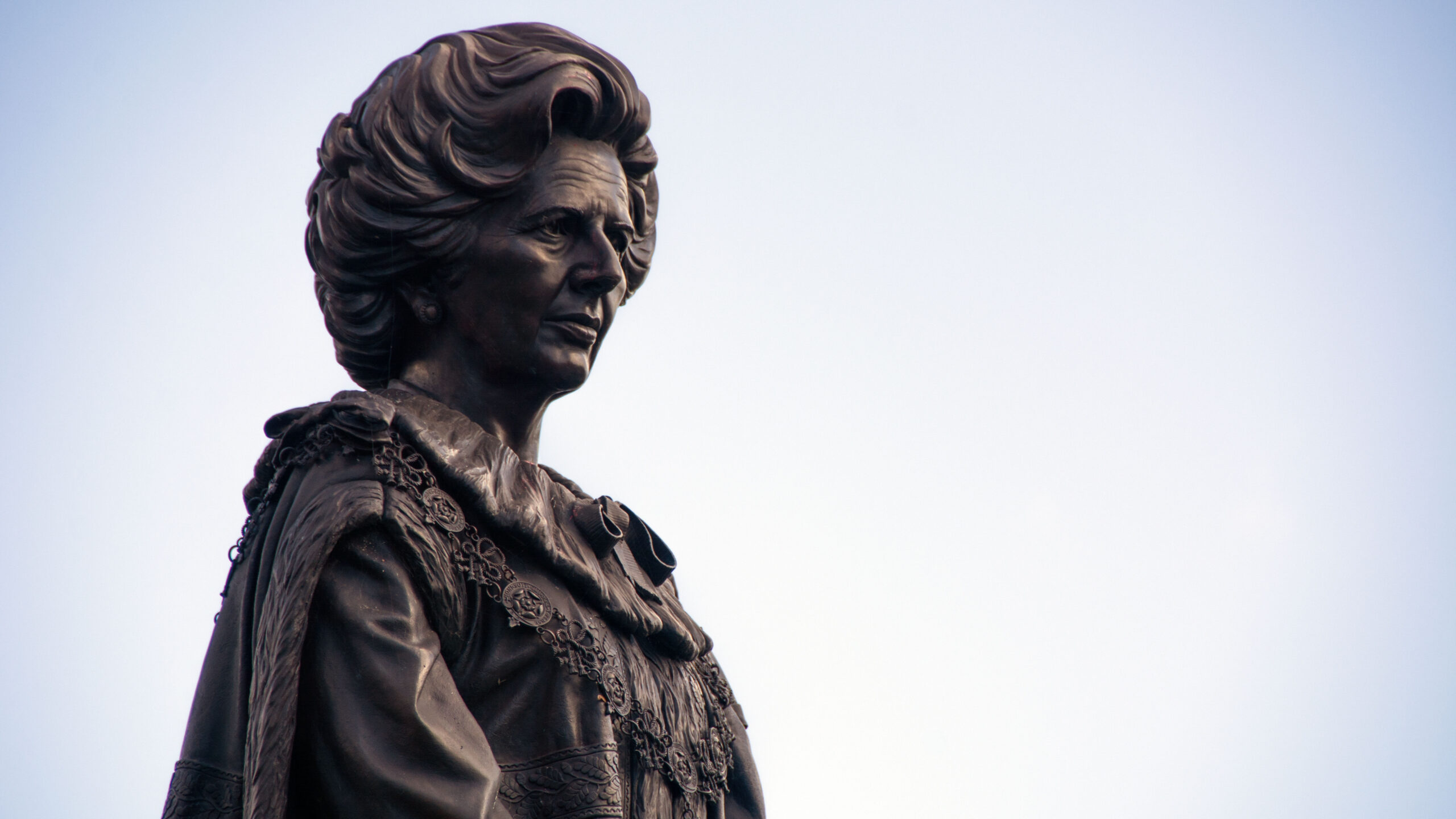There were two general elections in the 1980s and one Prime Minister – Margaret Thatcher. The decade was politically more stable electorally than the seventies when the country went to the ballot box to elect a leader four times.
Just as Harold Wilson dominated the sixties, Margaret Thatcher led the country for the whole of the eighties. Wilson’s dominance was significant, particularly for the current Labour leadership looking to history on how to win back power in 2024. However, Wilson is not often placed alongside the Beatles or the 1966 England World Cup winning squad in iconography of the 1960s. Margaret Thatcher, however, does sit comfortably and iconically alongside Princess Diana, Duran Duran and Madonna. The Iron Lady’s iconography also sits alongside economic and political heavyweights Friedrich Hayek, Milton Friedman, and US President Ronald Reagan – all as the theory and application of neoliberalism – a concept as polarising as Thatcher herself.
It was acceptable in the eighties
Dominic Sandbrook’s history of Britain in the eighties, Who Dares Wins sums the early part of the decade up well:
The early 1980s were the most dramatic, colourful and controversial in our modern history. Margaret Thatcher had come to power with a daring plan to reverse Britain’s decline into shabbiness and chaos. But as factories closed their doors, dole queues lengthened and the inner cities exploded in flames, would her harsh medicine rescue the Sick Man of Europe – or kill it off?
Unemployment hit three million during a “super recession” in the early eighties as seismic changes took place at home and abroad. The decade ushered in more service and finance jobs and less manufacturing and heavy industry. Thatcher argued that there was no alternative to her social and economic shock therapy. For many Thatcher is the icon and poster image of free market, libertarian individualism summed up by her famous claim that there was no longer any such thing as society. For others there really was no other alternative and the world was changing, and Britain had little choice but to be swept along with the new globalised world order.
In both 1983 and 1987, Thatcher won landslide victories against Labour leaders Michael Foot and Neil Kinnock following her first victory in 1979 against sitting Labour Prime Minister James Callaghan. Despite a decade of dominance in the 1980s, Thatcherism wasn’t an established worldview, political roadmap or ideology early on in the decade. In 1981, a royal wedding, the first airing of Only Fools and Horses, Ian Botham’s cricket heroics and winning the Eurovision song contest proved to be of little comfort as the country and the world faced economic recession. Monetarist policies and changes in trade union legislation battled both inflation and strikes and despite calls to the contrary, the early 1980s heralded changes politically, socially and economically – for some this heralded a watershed moment for change and for others it was efficiency and competition over social cohesion.
Thatcher was an outlier in many ways; she was the first female PM and a rare Prime Minister with a science degree. Some have attributed to her focus on science and technology policy to her own education. Margaret Thatcher played a part in changing the Conservative Party from upper class old school tie to aspiration and meritocracy. Her own story of a grocer’s daughter from Grantham going to Oxford to study chemistry and then going on to lead the country looms large in speeches and outlook. Her employment secretary Norman Tebbit famously told rioters and the three million unemployed in 1981 to follow her example and that of his father, and get on their bikes and find a job rather than riot.
Whatever your thoughts on Margaret Thatcher, the economic, social and cultural changes of the 1980s are clear in the decade’s general election manifesto texts of 1983 and 1987, including in the context of universities and higher education. The Conservative Party, the Labour Party and the SDP-Liberal Alliance produced in total six general election manifesto texts. Broadly, all three parties saw universities and higher education as part of the solution to global changes and crisis at home. All of the texts linked increased funding to teaching and research to develop new in-demand skills and calls were made for more applied research to improve a dire economic situation as well as to prepare all parts of society for the coming technological revolution.
The 1983 General Election
Higher education and universities saw an increase in volume of mentions throughout the 1980s. In 1983, the Conservative Party dedicated a whole section to higher education, sandwiched between “Schools: The Pursuit of Excellence” and “Sports and Recreation.” The section dedicated to the sector opens with:
Our universities and polytechnics, too, must generate new ideas and train the skilled workforce of the next generation. We have unrivalled institutions and unrivalled inventive genius – as the number of British Nobel prize-winners shows. What matters is to bring the two closer together and make the best practical use of both.
In the early 1980s, Britain had been dubbed “the sick man of Europe” and had little in the way of national pride – here we see a glimpse of Margaret Thatcher’s nationalism, which would be key to her premiership.
As employment opportunities changed, post-16 education had its part to play, and we can see similarities with 2024 calls for a tertiary system with a focus on skills. The 1983 Conservative text goes on to sing the praises of universities claiming that Britain had more students in higher education than France or West Germany with numbers increasing along with greater rates of completion than most other countries.
Despite heralding the success story of British universities and higher education a new vision is laid out. Concerns were growing in Number 10 about the increasing cost of higher education to the public purse. And a policy lever that would be pulled if re-elected would be to ensure that public money would be spent effectively. The Conservatives thought that this was best achieved by seeing “a shift towards technological, scientific and engineering courses.” The manifesto promised funding for more lecturers to bring new blood into research and more teaching and research on information technology, and students. This is echoed in a section in the manifesto titled “Help for the New Technologies” with research and development in universities playing a key role in the coming information technology revolution.
Labour also dedicated whole sections to further and higher education in its 1983 manifesto. The manifesto itself is famous in its own right for being described as the longest suicide note in history. The text espoused socialist principles just as Thatcherism as an opposing ideology was taking shape. Embedded in a section on “Education for the future” with sub-headings of “Post 16 education” “Adult education” and “A new deal for young people” Labour, led by Michael Foot, laid out its plans for the sector.
Labour’s manifesto proposed a “tertiary awards council” to replace a rigid A level system to prevent over-specialisation and to encourage flexibility and breadth. Funding was key to all of this for Labour in 1983 – it rejected Tory proposals for student loans and promised more places in higher education and to significantly expand opportunity and funding in adult education. This included financial support as well as ensuring universities made admissions and study more flexible.
The 1983 Liberal-SDP Alliance election manifesto covered education and training in one section. This opens with human capital-oriented perspective:
The principal need in education and training is to release the full potential of the individual. It is on the skills and energies of our people that our survival depends. An increasingly complex and technical society places great demands on the educational system and as falling school numbers continue to release resources these must not be withdrawn but invested to create better education opportunities.
The alliance promised specifically on higher education to increase access to both higher and further education and to “review to the structure of…higher education to see that people who are keen to work in industry are provided with the right range of skills at this level. This may mean for example students typically taking a wider range of courses before moving on to a job or more specialist education.”
The Liberal alliance also advocated for adult and continuing education:
Initial education alone cannot prepare people adequately for life. It must be made easier for them as part of their normal development to acquire new skills and to refrain as technology advances. Improvement in training facilities provided by the State will be accompanied by fiscal and other incentives to companies to increase their training efforts.
The 1983 Liberal-SDP Alliance was the first post-war manifesto to link British higher education to international relations:
Conservative policy towards the poor countries of the world has been mean and short sighted, reducing the level of British aid and effectively excluding Third World students from our higher education system. The widespread pursuit of restrictive policies has plunged the world into the worst slump for 50 years, and the poor countries have suffered most. On the other hand, Labour’s restrictive trade policies would be extremely damaging to the developing world. There is no hope for them or for the rest of the world if protection leads on to waves of retaliation and countries destroy each other’s markets, sending the world economy spiralling further downwards.
1983’s election pitted leaders Michael Foot and Margaret Thatcher in competition – their political perspectives were starkly different. As two political worldviews divided the world throughout the 1980s, Two Tribes went to war as the Cold War and nuclear threats remained a constant throughout the decade. In 1983 as with the end of the decade, free markets and capital won the battle of political ideas, as did Thatcher over Foot. Thatcherism was beginning to be established and espoused, small state, free markets and proud nationalism as its tenets.
The 1987 General Election
1987 saw a spike in volume of mentions in post-war general election manifestos. Margaret Thatcher’s third and final, winning campaign manifesto of 1987 saw continuity from 1983. Embedded in a section titled “raising standards in education” the sub-section “higher and further education” in the 1987 Conservative manifesto emphasised again that the British higher education system was the best in the world but the Conservative Party stressed that it must continue to fuse different modes of the university together with ideals of the ivory tower with efficiency and skills to compete in international markets:
We recognise the value of research and scholarship for their own sake. At the same time we must meet the nation’s demand for highly qualified manpower to compete in international markets.
Higher education post-war growth was still in the ascendancy, and the 1987 Conservative manifesto published increased numbers of students since taking office in 1979. Changes were promised more structurally, with a pledge to replace the University Grants Committee with an independent statutory body, responsible for funding with academic and non-academic representation, chaired by someone “who has substantial experience outside the academic world.”
Further structural changes were planned for polytechnics; the Conservative Party promised complimentary to universities to make them free standing corporate entities and to delegate power and responsibility by taking them out of local authority control. This was supported by the SDP Liberal Alliance. Of course, what eventually happened was that polytechnics were given university status in 1992.
Again in 1987 an SDP Liberal Alliance campaigned for power before the Liberal Democrat Party was formed in 1988. The liberals promised increased funding for more people to benefit from higher education – something they argued that the country lagged behind others globally. The same went for basic research (mode 1). Lifelong learning and seeing learning as a lifelong process was linked to widening access and national skills development.
The SDP Liberal Alliance, similarly to the Conservative Party, had structural and funding changes on their minds and the Liberal Alliance promised a higher education council to co-ordinate universities and polytechnics. In a section dedicated to the oncoming technological revolution, the SDP Liberal Alliance proposed Information Technology Centres in collaboration with colleges, polytechnics and universities.
Following Labour’s 1983 manifesto, new leader Neil Kinnock had put in motion changes to the party which would see a long revolution beyond his tenure – starting with removal of commitments to nationalise industry and unilateral nuclear disarmament. In the first manifesto text of Kinnock’s leadership in 1987, Labour talked up the value of research and teaching and promised to fund universities and polytechnics so that they had the resources to show such value.
Very much in the style of the 1960s Robbins Report, Labour promised to “expand the opportunity for all qualified young people seeking higher education to secure places.” Labour also embraced adult access to provide a ‘second chance’ of personal development to help provide and respond to rapid economic and social change. In line with the other parties, Labour agreed that investment in research was needed to maintain excellence but also to encourage industrial and commercial application of research output.
As Neil Kinnock changed the course and direction of the Labour Party, one of his most famous speeches centred on going to university. At the Welsh Labour Party conference in May, 1987, a month before the general election, Kinnock gave the swashbuckling “Why Am I the First Kinnock in a Thousand Generations?” speech. The Labour leader defined the party as caring democratic socialists and the speech asked why he and his wife, Glenys, were the first in a thousand generations to go to university. He rhetorically asked if previous generations of working people were thick and lacked talent. Showing that they emphatically were not, Kinnock listed many of those previous generations’ achievements. He proclaimed there was no platform and opportunity for them to go to university – an opportunity he and his wife were able to grasp and he promised to extend these opportunities. The speech had such an impact that it has been “plagiarised” by US President, Joe Biden.
The 1980s was dominated by Margaret Thatcher and the Conservative Party. Thatcher drew energy from conflicts with the trade unions, described as “the enemy within” and with Argentina (and Diego Maradona on the football pitch) over the Falklands. Thatcher was supportive of universities and advocated for high standards and saw them as a source of national pride.
Despite so much adversarial and ideologically polarised politics in the 1980s domestically and internationally, we do find consensus around higher education and universities. Growth was still on the agenda. As the country found itself economically struggling, teaching and research was seen as the solution rather than the problem, particularly around research findings being applied to real world issues. In the decade of the Walkman, video recorder, microwave and personal computer, all major parties saw the oncoming technological revolution and higher education had its part to play. Skills, post-16 tertiary systems for individual and collective flourishing and development was all part of a broader consensus on higher education and universities.
Thatcher saw her own education as opportunity and aspiration but she didn’t believe that they should be funded by the public purse – as with much of society and the legacy of Thatcherism. Here we can see the emergence of a bigger and more influential sector and the market forces that we see today dominating choice and economic gain.
Whether it was Thatcher and Thatcherism that moved society and higher education in this direction or global or bottom up forces is still debated. The Labour Party also changed significantly throughout the decade and continued to do so until they entered Downing Street in 1997. A victory that Margaret Thatcher claimed as one of her biggest successes and legacies – she later said that the arrival of Tony Blair and New Labour demonstrated how she had forced her opponents to change their mind.




